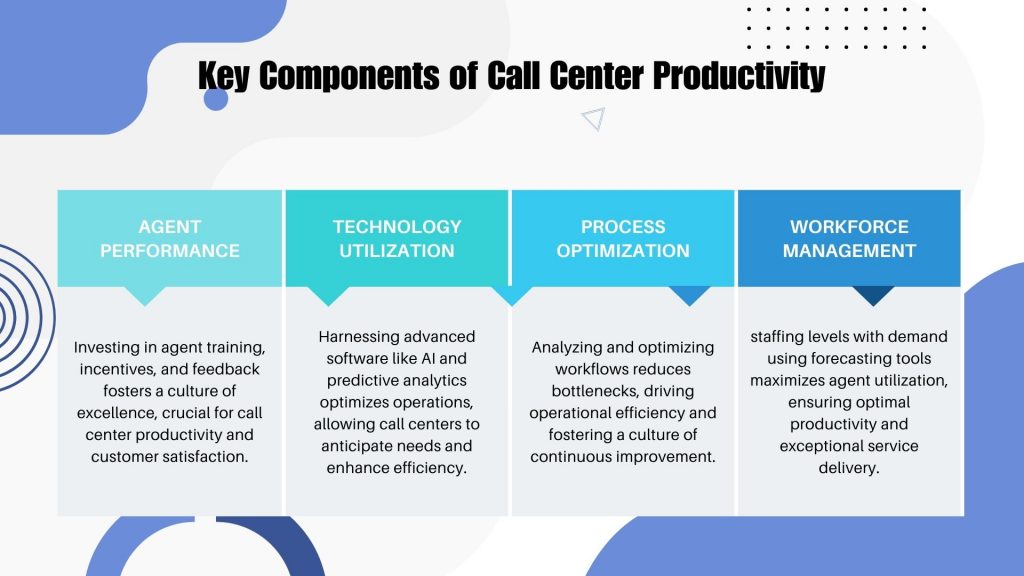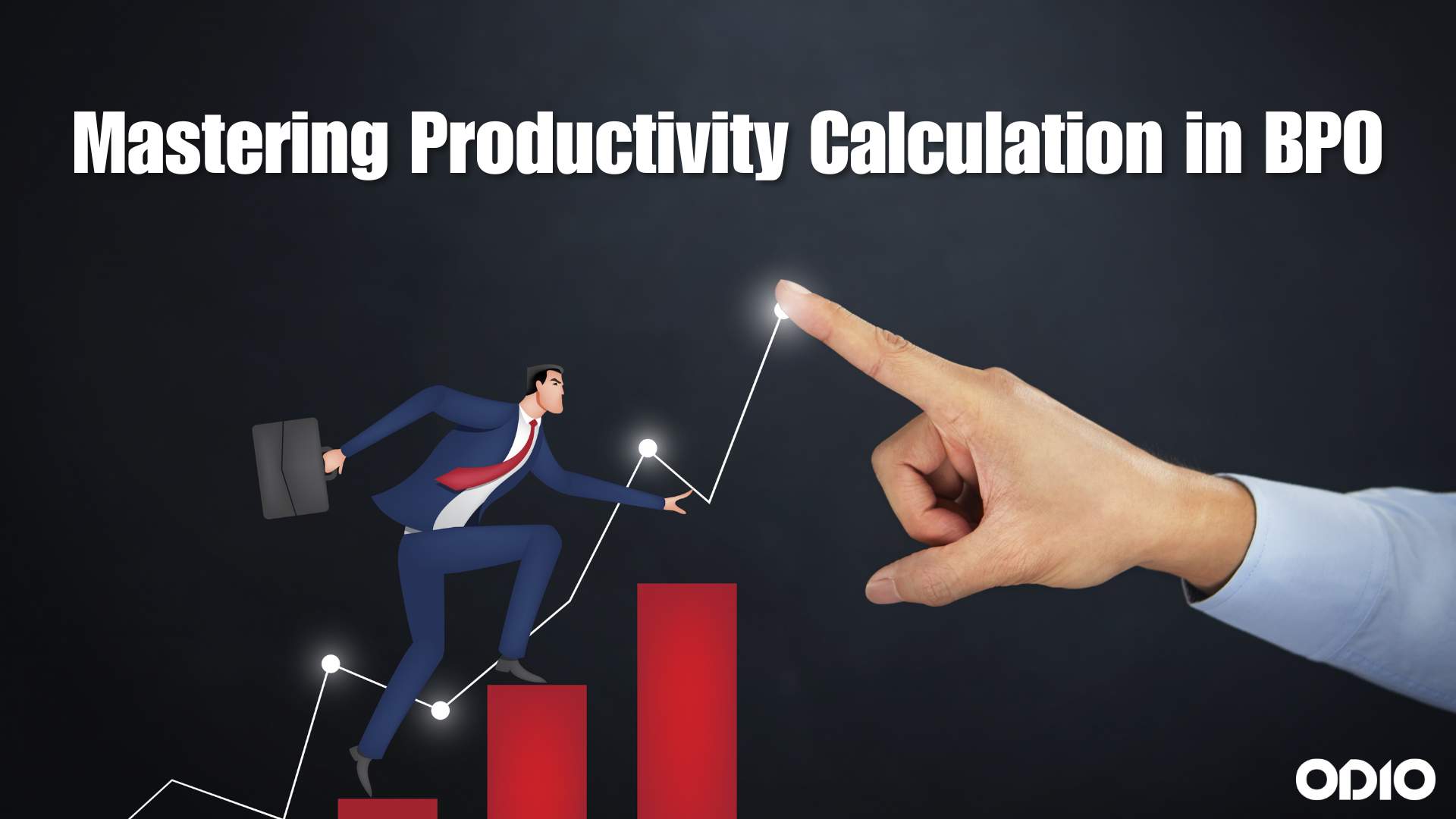Introduction
In the fast-paced world of Business Process Outsourcing (BPO), specifically call centers, maximizing productivity isn’t just a goal; it’s a necessity. According to a study by Deloitte, 65% of BPOs consider productivity calculation crucial for strategic decision-making. With the ever-growing demands of customers and the competitive landscape, call centers are constantly seeking ways to enhance efficiency and performance. One crucial aspect that holds the key to unlocking exponential growth is mastering productivity calculation. Let’s delve into the world of call center productivity and explore how you can achieve 2X growth through innovative approaches and insightful metrics.
What is Productivity in a Call Center?
Productivity metrics in a call center encompass a range of key performance indicators (KPIs) that gauge various aspects of operations. These metrics include but are not limited to average handling time (AHT), first call resolution (FCR), occupancy rate, and service level agreements (SLAs). By comprehensively understanding these metrics, call centers can evaluate performance, identify bottlenecks, and implement targeted improvements. According to a report by McKinsey, efficient call center operations can result in a 15-20% increase in productivity. As you’ve guessed, understanding these metrics is crucial for optimizing performance and achieving organizational objectives. Therefore, Let’s delve into some key performance indicators (KPIs) that play a pivotal role in measuring and enhancing productivity:
Average Handling Time (AHT)
AHT measures the average duration of interactions handled by agents, including talk time, hold time, and after-call work. It reflects the efficiency of agents in resolving customer queries and issues promptly. By monitoring and reducing AHT, call centers can streamline operations and improve overall productivity.
First Call Resolution (FCR)
FCR signifies the percentage of customer inquiries resolved during the initial interaction without the need for follow-up contacts. It reflects the effectiveness of agents in addressing customer needs efficiently and demonstrates operational efficiency. Improving FCR rates not only enhances customer satisfaction but also boosts agent productivity by minimizing repeat calls.
Occupancy Rate
Occupancy rate measures the percentage of time agents spend actively engaged in handling customer interactions compared to idle time or non-productive activities. It indicates the utilization of agent resources and workload management efficiency. Balancing occupancy rate ensures optimal agent productivity without leading to burnout or decreased performance.
Service Level Agreements (SLAs)
SLAs define the agreed-upon response and resolution times for customer inquiries and issues. Meeting SLAs demonstrates the call center’s commitment to delivering timely and quality service to customers. Monitoring SLA adherence enables call centers to identify areas for improvement and ensure optimal resource allocation to meet customer expectations.
Key Components of Call Center Productivity: Unlocking Efficiency
Call center productivity encompasses various components that collectively drive operational efficiency and performance. Understanding these key components is essential for implementing targeted strategies to enhance productivity:
Agent Performance: Empowering Frontline Ambassadors
Agents are the cornerstone of call center productivity, directly influencing customer experience and operational efficiency. Enhancing agent performance through comprehensive training, performance incentives, and feedback mechanisms is critical for achieving productivity goals. Investing in agent development and empowerment cultivates a culture of excellence and fosters long-term success.
Technology Utilization: Leveraging Tools for Efficiency
Technology plays a pivotal role in optimizing call center operations and improving productivity. Leveraging advanced software solutions for call routing, CRM integration, and workforce management enhances efficiency and streamlines processes. Embracing innovative technologies such as artificial intelligence (AI) and predictive analytics enables call centers to anticipate customer needs and proactively address issues, driving productivity gains.
Process Optimization: Streamlining Workflows for Efficiency
Efficient processes are the backbone of call center productivity, minimizing unnecessary steps and maximizing output. Analyzing and optimizing workflows, from call handling procedures to escalation protocols, reduces bottlenecks and improves operational efficiency. Implementing lean principles and continuous improvement initiatives fosters a culture of efficiency and drives sustainable productivity gains.
Workforce Management: Balancing Resources for Optimal Performance
Effective workforce management is essential for aligning staffing levels with fluctuating call volumes and customer demand. Utilizing workforce management tools and forecasting techniques enables call centers to optimize staffing schedules, minimize idle time, and maximize agent utilization. By maintaining the right balance between staffing resources and workload, call centers can enhance productivity while ensuring exceptional service delivery.

Role of Agents in Driving Productivity
Agents serve as the frontline ambassadors of a call center, directly impacting productivity through their actions and interactions. Their proficiency, adherence to processes, and engagement levels significantly influence operational efficiency and customer satisfaction. Empowering agents with the right tools, training, and support is paramount in maximizing their productivity and fostering a culture of excellence.
Why is Productivity Important in Call Center?
In call center operations, productivity isn’t just a metric; it’s the lifeline that sustains competitiveness and drives business growth. According to a survey by Forrester, companies that prioritize customer experience achieve 1.6 times higher YoY revenue growth compared to those that don’t. Not only this, a report by Gartner shows that organizations that prioritize call center efficiency will experience a 20% increase in customer satisfaction by 2025. Understanding the significance of productivity sheds light on its transformative power within the call center industry.
Impact on Customer Satisfaction: Fueling Positive Experiences
Call center productivity directly correlates with customer satisfaction, forming the bedrock of exceptional service delivery. Efficient handling of inquiries, swift issue resolution, and personalized interactions leave a lasting impression on customers, fostering loyalty and advocacy. By prioritizing productivity, call centers can elevate the customer experience and strengthen relationships, paving the way for sustained success.
Cost Efficiency and Resource Optimization: Maximizing ROI
Productivity optimization isn’t just about doing more; it’s about doing more with less. Streamlining processes, optimizing workflows, and leveraging technology minimize operational costs while maximizing output. By enhancing efficiency and resource utilization, call centers can achieve significant cost savings and bolster profitability. Productivity-driven cost efficiencies ensure sustainable operations and create a competitive edge in the market.
Competitive Advantage in the Market: Setting the Bar High
When call centers are competitive, productivity serves as a distinguishing factor that sets industry leaders apart from their counterparts. Call centers that prioritize productivity gain a strategic advantage by delivering superior service, attracting top talent, and outperforming competitors. By continuously refining operations and embracing innovation, organizations can position themselves as market leaders and drive sustainable growth.
Driving Business Growth and Revenue: Fueling Expansion
At its core, productivity fuels business growth and revenue generation, propelling call centers towards new heights of success. Increased efficiency, optimized performance, and enhanced customer satisfaction translate into tangible business outcomes, including revenue growth, market expansion, and brand recognition. By investing in productivity enhancement initiatives, call centers lay the foundation for long-term prosperity and unlock opportunities for strategic expansion and diversification.
How to Calculate Call Center Productivity?
Efficient productivity measurement is the cornerstone of effective call center management. By understanding the methodologies and factors involved in productivity calculation, call centers can gain actionable insights to drive performance and optimize operations. Let’s explore the essential aspects of calculating call center productivity:
Understanding Productivity Formulas: Unlocking Insights
- Productivity Ratio Formula: The productivity ratio is calculated by dividing the total output by the total input. In a call center context, output can be quantified as the number of resolved customer inquiries or transactions, while input includes factors such as agent hours worked or resources expended. This formula provides a comprehensive overview of overall productivity levels.
- Agent Productivity Formula: Agent productivity is determined by dividing the total output generated by an agent by the total input (typically measured in hours worked). This formula enables call centers to assess individual agent performance and identify opportunities for improvement. By tracking agent productivity metrics, managers can allocate resources effectively and provide targeted coaching and support.
- Cost per Call Formula: Cost per call measures the average cost incurred by the call center for handling each customer inquiry. It is calculated by dividing the total operating costs by the number of calls handled during a specific period. Monitoring cost per call helps call centers evaluate cost efficiency and identify cost-saving opportunities without compromising service quality.
Factors to Consider in Calculation: Navigating Complexity
- Operational Efficiency: Assessing operational efficiency involves analyzing various factors such as call handling time, agent utilization, and resource allocation. By identifying inefficiencies and optimizing processes, call centers can enhance productivity and streamline operations.
- Quality of Service: Productivity measurement should not come at the expense of service quality. Call centers must balance productivity goals with delivering exceptional customer experiences. Monitoring customer satisfaction metrics alongside productivity metrics ensures that efficiency gains do not compromise service excellence.
- Technology Integration: Leveraging technology solutions for data collection, analysis, and reporting streamlines productivity calculation processes. Integrating workforce management systems, CRM platforms, and analytics tools enables call centers to gather real-time insights and make informed decisions to drive productivity improvements.
Call Center Productivity Metrics
Call center productivity metrics serve as the compass guiding call centers towards operational excellence and customer satisfaction. By meticulously tracking and analyzing these metrics, organizations can gain actionable insights into performance and drive continuous improvement.
- Data-Driven Decision-Making: Leveraging call center productivity metrics empowers organizations to make informed decisions based on data insights rather than intuition. By identifying trends, patterns, and performance gaps, call centers can implement targeted strategies to drive continuous improvement and achieve operational excellence.
- Performance Benchmarking: Benchmarking call center productivity metrics against industry standards and best practices provides valuable context for performance evaluation and goal setting. Benchmarking enables organizations to identify areas for improvement and implement strategies to enhance competitiveness and performance.
Conclusion: Driving Performance and Innovation in Call Centers
As we conclude our exploration of call center productivity, it’s evident that mastering productivity calculation is the key to unlocking unparalleled growth and efficiency in the call center industry. By leveraging insightful metrics, implementing targeted strategies, and fostering a culture of continuous improvement, call centers can optimize performance, enhance customer satisfaction, and drive business success.
Call center productivity is not just a metric; it’s a strategic imperative for call centers seeking to thrive in today’s dynamic business environment. By mastering productivity calculation, implementing targeted strategies, and embracing innovation, organizations can unlock unprecedented growth, efficiency, and success in the call center industry.
What strategies will your organization implement to enhance call center productivity and drive future success? Share your thoughts and insights in the comments below!
Thank you for joining us on this journey through the realms of AI and cost-effective call center strategies. For more insightful content, stay tuned to our blogs at Odio.

Leave a Reply